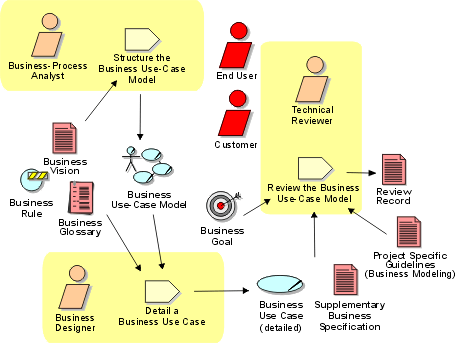Workflow Detail: Refine
Business Process Definitions
|
The purpose of this workflow detail is to detail the business process descriptions and describe how they support the business goals. |
|
|
|
Description

Each business use case will be assigned to a subset of the business-modeling team, who will describe it in detail. Acting as business designer, this subset team will complete the definition of the business use case and lead a review session for it. Other members of the business-modeling team are invited to this review session to act as business-model reviewers. The business designers might also invite representatives of the stakeholders to the project, such as end users.
The purpose of this workflow detail is to:
- Detail the definition of the business use cases.
- Describe how the business use cases support the business goals.
- Verify that the business use case correctly reflects how business is conducted.
It may be necessary to restructure the Business Use Case Model to improve understanding or readability, but restructuring should not be attempted too early. This is because it is best to wait until the level of understanding of the business use cases has become sufficient enough to prevent the introduction of unnecessary complexity during restructuring. Usually, any necessary restructuring should be performed after this workflow detail has been reached.
Common sub-flows might be identified, as well as relationships between business use cases. Business use cases may also be grouped into packages. Restructuring should occur only to make the model more understandable or manageable.
Once the business use cases have become somewhat stabilized, the highest priority ones must be detailed. This entails further describing each step of the business use case, as well as completing its remaining properties (preconditions, post-conditions, and special requirements). While detailing the highest priority business use cases, certain quantitative and qualitative requirements governing their behavior might be discovered (for example, required turnaround time or process flexibility). If these requirements are applicable to the business use case only, they should be captured in the Special Requirements property of the business use case. Otherwise, they should be captured in the Supplementary Business Specification.
The Business Use Case Model must be reviewed to ensure that it remains succinct and understandable to all stakeholders. The Supplementary Business Specification must also be reviewed to ensure that the requirements are clear and realistic.
Related Information 
This section provides links to additional information related to this workflow detail.
Timing 
Begins in Inception phase, repeated in later iterations as required/planned.
Optionality 
Recommended for business modeling efforts aimed at engineering or re-engineering a business.
How to Staff

A person acting as business designer must have strong writing skills. Knowledge of the business domain is, of course, also helpful, but this can be obtained by involving domain experts as reviewers.
Work Guidelines

The core development team must conduct a few rounds of internal walkthroughs facilitated by the business designer. These walkthroughs will clean up any inconsistencies before the work of the core development team is more formally inspected and reviewed by the extended team.
The team divides the material so that they do not have to review everything at once. The review meeting (covering the most important business use cases) should not take more than a day.
Activity: Review the Business Use-Case Model contains checklists that will be helpful when you are reviewing a business use case. See also Work Guideline: Reviews.
This content developed or partially developed by  Empulsys BV. Empulsys BV.
|

